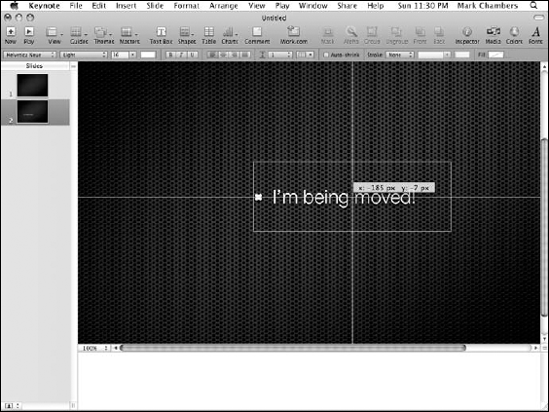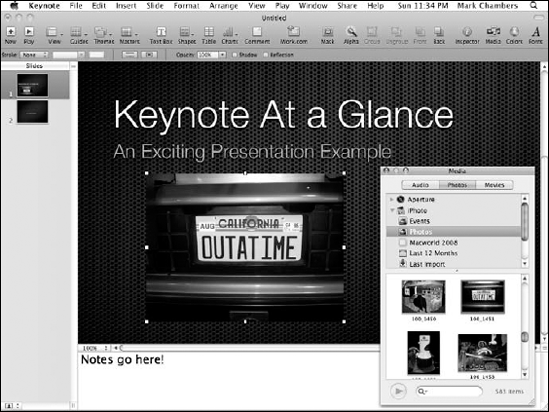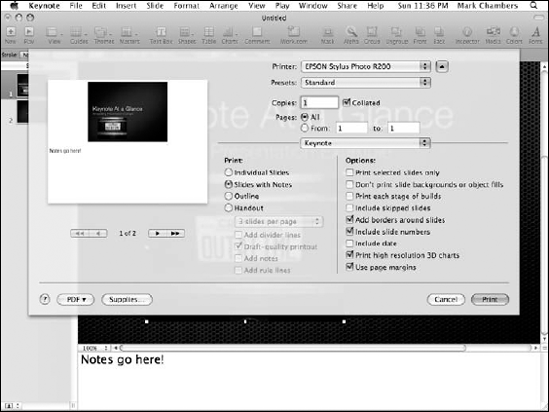In This Chapter
Creating a new presentation
Adding slides
Using selection boxes
Entering and editing text
Formatting text
Adding presenter's notes
Inserting media and shapes
Running a slideshow
Printing slides and notes
It seems like only yesterday that I was giving business presentations with a clunky overhead projector and black-and-white acetate transparencies. Fancy color gradients and animation were unheard of, and the only sound my presentations made was the droning of the projector's fan. I might as well have been using tree bark and chalk.
Thank goodness those days are gone forever, because cutting-edge presentation software like Keynote makes slide creation easy and — believe it or not — fun! This is the application that Steve Jobs once used for his Macworld keynotes every year, and there's so much visual candy available that you'll never need to shout to wake your audience again. Naturally, Keynote is a perfect match for your MacBook, allowing you to create or edit a presentation while you're on the road.
In this chapter, I demonstrate how simple it is to build a stunning Keynote presentation, and how to start and control your slide display from your keyboard (or even your iPhone or iPod touch). Heck, we'll even print your slides and notes so that your audience can keep a copy of your brilliant work!
As do the other applications in the iWork '09 suite, Keynote begins the document creation process with a Template Chooser window. To create a new presentation project, follow these steps:
Double-click your hard drive icon and click the Applications entry in the Finder window sidebar. Double-click the iWork folder to open it.
Tip
If presentations are your bread and butter, allow the iWork installation program to add a Keynote icon to your Dock. Your clicking finger will thank you.
Double-click the Keynote icon.
The Template Chooser window that you see in Figure 3-1 appears. (I have to say that these are probably the most stunning visual building blocks I've ever seen in a presentation application. You should have heard the "oohs" and "ahhs" from the Macworld faithful when Steve Jobs demonstrated Keynote for the first time on the big screen!)
Click the Slide Size pop-up menu at the bottom of the screen to select the resolution for your completed slides.
Although you don't necessarily need to select an exact match for the screen resolution of your MacBook, it's a good idea to select the closest value to the maximum resolution of your projector. (If someone else is providing the projector, the default value of 1024 × 768 is a good standard to use.)
Click the template that most closely matches your needs.
Click Choose to open a new document by using the template you selected.
If an existing Keynote presentation file is visible in a Finder window, you can double-click the document icon to open the project. If Keynote is already running, however, follow these steps to load a project:
Press

Click the desired drive in the Devices list at the left of the dialog; then click folders and subfolders until you've located the Keynote project.
Double-click the filename to load it.
Tip
If you want to open a Keynote document that you've edited in the recent past, things get even easier! Just click File
When you're done working on a Keynote presentation (or if you'd simply like to safeguard your work in a world of power failures), follow these steps:
Press

If you're saving a document that hasn't yet been saved, the familiar Save As sheet appears.
Type a filename for your new document.
Click the Where pop-up menu and choose a location to save the document.
To select a location not on the Where pop-up menu, click the button with the down arrow symbol to expand the sheet. You can also create a new folder from the expanded sheet.
Click Save.
Ready for the 5-cent tour of the Keynote window? Launch the application and create or load a project, and you'll see the tourist attractions shown in Figure 3-2:
Slide list: Use this thumbnail list of all the slides in your project to help you navigate quickly. Click a thumbnail to switch instantly to that slide.
Tip
The Slide list can also display your project in outline format, allowing you to check all your discussion points. (This is a great way to ferret out any "holes" in your presentation's flow.) While in outline mode, you can still jump directly to any slide by clicking the slide's title in the outline. To display the outline, click View

Layout pane: Your slide appears in its entirety in this pane. You can add elements and edit the content of the slide from the Layout pane.
Toolbar: As does the toolbar in Pages and Numbers, Keynote's toolbar makes it easy to find the most common controls you'll use while designing and editing your slides. Clicking an icon in the toolbar performs an action, just as selecting a menu item does.
Notes pane: If you decide to add notes to one or more slides (either for your own use or to print as additional information for your audience), click View

Format Bar: Keynote displays this button strip underneath the Keynote toolbar, allowing you to format selected text, paragraphs and lists on the fly.
Sure, Keynote creates a single Title slide when you first create a project, but not many presentations are complete with just a single slide! To add more slides to your project, use one of these methods:
Click the New button on the Keynote toolbar.
Choose New Slide from the Slide menu.
Press

Right-click (or Control-click) in the Slides list and choose New Slide from the menu.
Keynote adds the new slide to your Slides list and automatically switches to the new slide in the Layout pane.
Tip
Need a slide that's very similar to an existing slide you've already designed? Right-click the existing slide and choose Duplicate to create a new slide just like it. (Consider it cloning without the science.)
To move slides to different positions in the Slides list (and therefore a different order in your Keynote slideshow), drag each slide thumbnail to the desired spot in the list.
You've probably noticed that all the text within your first Title slide appears within boxes. Keynote uses boxes to manipulate text and graphics. You can resize a box (and its contents) by clicking and dragging one of the handles that appear around the edges of the box. (Your mouse cursor will change into a double-sided arrow when you're "in the zone.") The side-selection handles drag only that edge of the frame, whereas the corner-selection handles resize both adjoining edges of the selection frame.
Tip
To keep the proportions of the box constrained, hold down Shift while dragging the corner handles.
Boxes make it easy to move text and graphics together (as a single unit) to another location within the Layout pane. Click in the center of the box and drag the box to the desired spot; Keynote displays alignment lines to help you align the box with other elements around it (or with regular divisions of the slide, like horizontal center). As you can see in Figure 3-3, I'm moving a box on the slide to a new location, and Keynote has supplied alignment lines to help me place it correctly.
Note
To select text or graphics within a box, you should double-click the box.
Tip
If you're resizing a photo in a box, don't forget to hold down the Shift key as you drag the frame. Doing so specifies that Keynote should preserve the aspect ratio of the image so that the vertical and horizontal proportions remain fixed. You can also flip images horizontally or vertically from the Arrange menu.
As with Pages and Numbers — which also use boxes for text layout — Keynote allows you to add or edit text with ease. For example, double-click in a box with the text Double-click to edit, and the placeholder text disappears, leaving the field ready to accept new text. Any new text you type appears at the blinking cursor within the box.
To edit existing text in your Keynote document, click using the bar-shaped cursor to select just the right spot in the text, and drag the insertion cursor across the characters to highlight them. Type the replacement text, and Keynote obligingly replaces the text that was there with the text you type.
If you want to delete existing text, click and drag across the characters to highlight them; then press Delete. You can also delete an entire box and all its contents: Right-click (or Control-click) the offending box and choose Delete from the menu that appears.
When the contents of a box are just right and you're finished entering or editing text, click anywhere outside the box to hide it from view. You can always click the text again to display the box later.
Keynote doesn't restrict you to the default fonts for the theme you chose. It's easy to format the text in your slides — you can choose a different font family, font color, text alignment, and text attributes such as bolding and italicizing on the fly, whenever you like.
Select the desired text by double-clicking a box and then dragging the text cursor to highlight the characters. Now apply your formatting using one of these two methods:
The Format Bar: The font controls on the Format Bar work just as the controls on the toolbar do: Either click a font control to display a pop-up menu or click a button to immediately perform an action. Clicking the Font Size pop-up menu, for example, displays a range of sizes for the selected text — with a single click on the B (bold) button, you'll add the bold attribute to the highlighted characters.
The Format menu: The controls on the Format menu generally mirror those on the Format Bar. To change the alignment from the Format menu, click Format and hover the mouse cursor over the Text menu item. To change text attributes, click Format and hover your mouse over the Font menu.
As I mention earlier, you can type text notes in the Notes pane — I use them for displaying alternate topic points while presenting my slide show. However, you can also print the notes for a project along with the slides, so presenter's notes are also great for including reminders and To Do points for your audience in handouts.
To type your notes, just click within the Notes pane; if it's hidden, click View
Tip
To display your notes while practicing, use Keynote's Rehearsal feature. Click Play and choose Rehearse Slideshow, and you can scroll through the notes while the slideshow runs. (More on slideshows in a second.)
Adding audio, photos, and movies to a slide is drag-and-drop easy in Keynote! Simply drag an image, audio, or movie file from a Finder window and place it at the spot you want within your document.
You can also use the Media Browser — click the Media button on the toolbar and click the Audio, Photos, or Movies button to select the desired type. Keynote displays the contents of your various media collections — like your iPhoto and iTunes libraries — or you can also navigate to the file's location on your hard drive, or type in a filename in the Search box at the bottom of the browser. When you've found the file you want to add, drag it to the spot you want in the document. Figure 3-4 illustrates the Media Browser in action.
Text often stands out on a slide when it sits on top of a background shape. To add a shape (such as a rectangle or circle) as a background for your text, follow these steps:
Click the insertion cursor in the location you want.
Click the Shapes button on the Keynote toolbar and choose a shape.
The shape appears in your document.
Click the center of the shape and drag it to a new spot.
As with image boxes, shapes can be resized or moved.
When the shape is properly positioned and sized, select it and choose Arrange

The heart of a Keynote presentation is the slideshow that you build from the slides you've created. A Keynote slideshow is typically presented full screen, with slides appearing in linear order as they are sorted in the Slides list.
In its simplest form, you can always run a slideshow from a Keynote project by clicking the Play button in the toolbar, or by choosing Play
Of course, other controls are available besides just the ones that advance to the next slide! Table 3-1 illustrates the key shortcuts you'll use most often during a slideshow.
Table 3.1. Keynote Slideshow Shortcut Keys
Key or Key Combination | Action |
|---|---|
] (right bracket) | Next slide |
P | Previous slide |
Home | Jump to first slide |
End | Jump to last slide |
C | Show or hide the pointer |
(number) | Jump to the corresponding slide in the Slide list |
U | Scroll notes up |
D | Scroll notes down |
N | Show current slide number |
H | Hide slideshow and display last application used (the presentation appears as a minimized icon in the Dock) |
B | Pause slideshow and display a black screen (press any key to resume the slideshow) |
Esc | Quit |
Tip
Keynote offers a number of settings that you can tweak to fine-tune your slideshow. To display these settings, choose Keynote
Tip
If you have an iPhone or iPod touch handy and you've installed the Apple Keynote Remote application on your device, display the Preferences window and click the Remote button to link your iPhone or iPod touch to your MacBook and Keynote. Now you can use your handheld device as a remote and use it during your slideshow!
Okay, I'll be honest: I don't always print handouts for every presentation I give, just because some of the slideshows I run are short introductions to hands-on demonstrations. However, if you're presenting a lengthy slideshow with plenty of information that you'd like your audience to remember, nothing beats handouts that include scaled-down images of your slides (and, optionally, your presenter's notes).
You can also use Keynote to create an electronic PDF-format document instead of a printed handout, which your audience members can download from your Web site. (For the lowdown on PDF printing, visit Chapter 4 in Book VIII.)
To print a hardcopy of your slides and notes, follow these steps:
Within Keynote, click File and choose Print.
Keynote displays the Print sheet you see in Figure 3-5. (Note that some printer-specific features may be different on your screen.)
Click the desired format.
To print each slide on a separate page at full size, click Individual Slides.
To print each slide on a separate page with the presenter's notes for that slide, click Slides with Notes.
To print the contents of your Slides list in Outline view, click Outline.
To print a handout with multiple slides per page (and, optionally, with presenter's notes), click Handout. Click the Slides per Page pop-up menu to specify the number of slides that Keynote should print on each page.
Select the pages to print.
To print the entire document, select All.
To print a range of selected slides, select the From radio button and enter the starting and ending pages.
Select or deselect specific options from the Options column.
You can include elements such as the date, borders around each slide, and the slide number as part of each page of the hardcopy.
Click the Print button to send the job to your printer.





